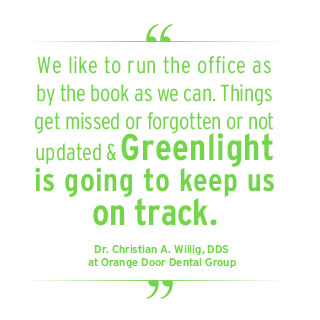Blog
Infection Prevention – Is Your Practice Doing Enough?

Compliance Enters the Digital Age with the GreenLight Dental Compliance Center™ by Hu-Friedy
Ask any dentist about their infection prevention program, and they’re likely to express confidence that they’re fully compliant with all relevant regulations. But is that really the case? The slow drip of infection prevention breach stories making news around the country would suggest that compliance is more of an issue than some would like to admit.
While each breach is different, there is a common theme – all too often, dentists simply don’t know they’re in violation until it’s too late. Moreover, small violations can have big consequences. Dentists in violation risk suspension, losing their license, civil litigation and liability, jail time, and lost business.
A study commissioned by Hu-Friedy and administered by The Key Group, an independent third-party market research company, found that while 99 percent of respondents believed their infection prevention programs were effective, many practices had programs that were not fully compliant. For instance, 66 percent of respondents were not compliant in their use of internal sterilization monitors.
Despite high levels of confidence, 62 percent expressed concern with their protocols when compared to published OSHA standards. Yet compliance covers more than just OSHA. CDC and state dental board regulations also factor into infection prevention programs and protocols. Part of what makes infection prevention so challenging is the fact that there is no “good enough” – only compliance or non-compliance.
With such a wide array of regulations, staying in compliance can feel like a daunting task. But infection prevention has entered the digital age with the GreenLight Dental Compliance Center™ by Hu-Friedy, a one-stop shop for all compliance needs, providing comprehensive access to guidelines and regulations from the CDC, state dental boards, and OSHA.
As the only resource available to dental professionals that organizes all information on infection prevention guidelines and regulations into one central location, GreenLight can take the burden out of compliance, helping to ensure a safe practice for patients and staff alike.
Here are a few ways GreenLight can help protect your practice:
Create Customized Infection Control Protocols
In many states, the lack of written infection control protocols is itself a compliance violation. It is critical for practices to document their processes and prepare for any scenario. Given the array of guidelines to draw from, this can be challenging. But whether a practice is setting up infection prevention protocols for the first time or revisiting existing protocols, GreenLight is the easiest way to evaluate current practices and develop an up-to-date program.
Practices can use GreenLight to self-assess their current protocols in areas ranging from sterilization monitoring, to waterline maintenance, to hazardous waste. Based on those results, practices can draw from templates provided by GreenLight to develop personalized protocols that adhere to their needs. Additionally, each new GreenLight member is eligible for a free consultation with Hu-Friedy’s team of experts, who will answer any questions that may arise as practices develop their infection prevention program.
Save Time on Staff Training and Continuing Education

In addition to information on written infection prevention protocols, GreenLight members have access to OSHA training and continuing education webinars on infection prevention, surface disinfection, hand hygiene, instrument management, and dental unit waterlines. These resources are great for dental professionals looking to refresh their knowledge on key compliance issues while gaining CE credit.
Meanwhile, new hires can easily complete their required OSHA training. GreenLight’s three-part OSHA webinar series has been specifically designed to meet OSHA training requirements for general safety, hazard communication, and bloodborne pathogens standards. GreenLight also offers quarterly live and on-demand OSHA update webinars, which focus on new information related to infection prevention issues that arise over the last quarter.
Often, temporary employees or new hires come with behaviors and habits they’ve learned elsewhere which may not align to a practice’s standards. Access to on-demand training resources can help practices ensure their staff are in alignment, so bad habits don’t take root.
Empower Infection Control Coordinators
CDC guidelines state that all practices should designate an Infection Control Coordinator (ICC) who is knowledgeable about infection control and willing to be educated above and beyond to ensure their practice complies with the latest standards and guidelines. This can be a challenging role to take on for any dental professional, particularly given their other clinical or administrative responsibilities.
Even with an ICC, staying on top of infection prevention is not easy, but GreenLight includes a page for the Infection Control/Prevention Coordinator to help them understand the role. ICCs can learn more about the responsibilities of the role, how to implement the position, and what resources are needed to succeed. Resources available include eBooks covering the basics of the role and instrument reprocessing, as well as tips to improve practice efficiency.
Additionally, for practices with multiple offices, ICCs can track implementation and compare metrics across each office. The online digital portal makes it easy to organize and access all the resources needed to manage compliance.
It’s important to note, however, that infection prevention is not just the responsibility of the ICC. While the ICC is a key driver of an infection prevention program, it is ultimately a team activity that requires buy-in from the whole staff. GreenLight provides the resources and tools to develop and maintain protocols, but it’s up to every practice to instill the right culture of accountability to ensure a well-functioning program.

